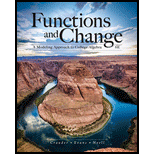
Concept explainers
Reminder Round all answers to two decimal places unless otherwise indicated.
An Investment You have invested money in a savings account that pays a fixed monthly interest on the account balance. The following table shows the account balance over the first 5 months.
| Time, in months | Saving balance |
|
|
|
|
|
|
|
|
|
|
|
|
|
|
|
|
|
|
a. How much money was originally invested?
b. Show that the data are exponential and find an exponential model for the account balance.
c. What is the monthly interest rate?
d. What is the yearly interest rate?
e. Suppose that you made this investment on the occasion of the birth of your daughter. Your plan is to leave the money in the account until she starts college at age 18. How large a college fund will she have?
f. How long does it take your money to double in value? How much longer does it take it to double in value again?
Want to see the full answer?
Check out a sample textbook solution
Chapter 4 Solutions
Functions and Change: A Modeling Approach to College Algebra (MindTap Course List)
- Q/(a)Let X be a finite dimension vector space over a field F and S₁,S2CX such that S₁SS2. Show that whether (1) if S, is a base for X then base for X or not (2) if S2 is a base for X then S, is a base for X or not (b) Show that every subspace of vector space is convex and affine set but the conevrse need not to be true. allet M be a non-empty subset of a vector space X over a field F and x,EX. Show that M is a hyperspace iff xo+ M is a hyperplane and xo€ xo+M. bState Hahn-Banach theorem and write with prove an application about it. Show that every singleten subset and finite subset of a normed space is closed. Oxfallet f he a function from a normad roace YI Show tha ir continuour aty.GYiffarrow_forward7 3 2 x+11x+24 9 2 5 x+11x+24arrow_forward2 4 + 4x 2x 8 || 12arrow_forward
- 1 5 1 2 3 1 6 7 -4 -3 -2 -1 0 1 2 3 -1 4 Which point is not included in the solution cot for the inequality? 5arrow_forwardWhich graph represents the solution of y > x2 + 2?arrow_forwardA boat's value over time, x, is given as the function f(x) = 400(b)x. Which graph shows the boat's value decreasing at a rate of 25% per year?arrow_forward
- A boat's value over time, x, is given as the function f(x) = 400(b)x. Graph the boat's value decreasing at a rate of 25% per year?arrow_forwardDescribe the y-intercept and end behavior of the following graph: 0 2 4 -2 -4 -6arrow_forwardComputing Ending Inventory under Dollar-Value LIFO Wheels Inc. accounts for inventory using the dollar-value LIFO method. The following information is available for Year 1 through Year 3 (listed chronologically). Year Ending Inventory at FIFO Price Index Year 1 Year 2 Year 3 $6,000 1.00 9,600 1.10 12,000 1.13 Compute ending inventory under the dollar-value LIFO method for Year 1, Year 2, and Year 3. • Note: Round your answers to the nearest whole dollar.arrow_forward
- Upland Co.'s inventory records showed the following data accounted for in a perpetual inventory system. Unit Date June 1 Units Cost Inventory (beg.) 700 $8.00 June 3 Purchases 1,400 8.40 June 7 Sales (at $16 per unit) 980 952 9.00 June 20 Purchases June 22 Sales (at $16 per unit) 1,540 What is (a) ending inventory on June 30, and (b) cost of goods sold for June, using the FIFO inventory method? •Note: Do not use negative signs with any of your answers. •Note: List the inventory units in chronological order based on their purchase date with beginning inventory, if any, listed first.arrow_forwardExplain how solve 4x + 3 = 7 using the change of base formula logy: logy. Include the solution for x in your answer. Round your answer to the nearest thousandth. log barrow_forward5. Consider the following vectors 0.1 3.2 -0-0-0 = 5.4 6.0 = z= 3 0.1 For each of exercises a-e, either compute the desired quantity by hand with work shown or explain why the desired quantity is not defined. (a) 10x (b) 10-27 (c) J+Z (d) (x, y) (e) (x, z)arrow_forward
 Functions and Change: A Modeling Approach to Coll...AlgebraISBN:9781337111348Author:Bruce Crauder, Benny Evans, Alan NoellPublisher:Cengage LearningAlgebra & Trigonometry with Analytic GeometryAlgebraISBN:9781133382119Author:SwokowskiPublisher:Cengage
Functions and Change: A Modeling Approach to Coll...AlgebraISBN:9781337111348Author:Bruce Crauder, Benny Evans, Alan NoellPublisher:Cengage LearningAlgebra & Trigonometry with Analytic GeometryAlgebraISBN:9781133382119Author:SwokowskiPublisher:Cengage
 Glencoe Algebra 1, Student Edition, 9780079039897...AlgebraISBN:9780079039897Author:CarterPublisher:McGraw Hill
Glencoe Algebra 1, Student Edition, 9780079039897...AlgebraISBN:9780079039897Author:CarterPublisher:McGraw Hill Big Ideas Math A Bridge To Success Algebra 1: Stu...AlgebraISBN:9781680331141Author:HOUGHTON MIFFLIN HARCOURTPublisher:Houghton Mifflin Harcourt
Big Ideas Math A Bridge To Success Algebra 1: Stu...AlgebraISBN:9781680331141Author:HOUGHTON MIFFLIN HARCOURTPublisher:Houghton Mifflin Harcourt Algebra: Structure And Method, Book 1AlgebraISBN:9780395977224Author:Richard G. Brown, Mary P. Dolciani, Robert H. Sorgenfrey, William L. ColePublisher:McDougal Littell
Algebra: Structure And Method, Book 1AlgebraISBN:9780395977224Author:Richard G. Brown, Mary P. Dolciani, Robert H. Sorgenfrey, William L. ColePublisher:McDougal Littell





